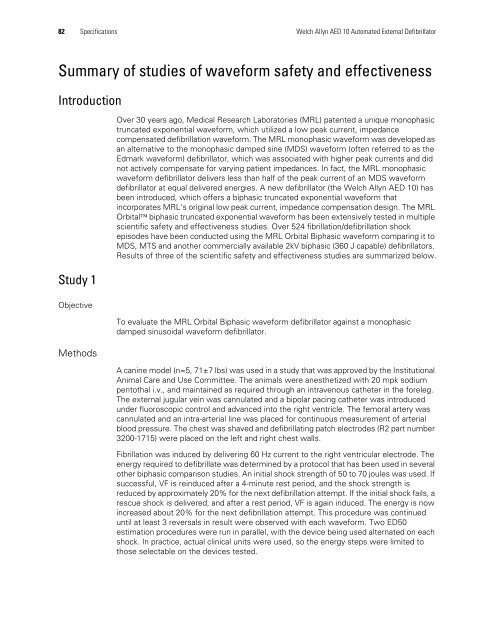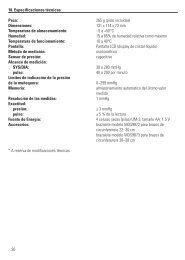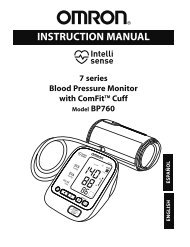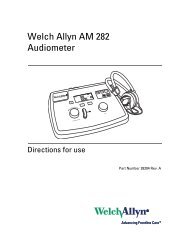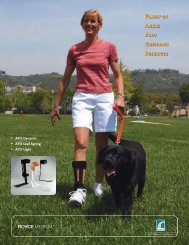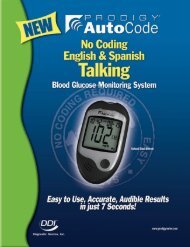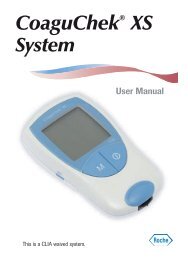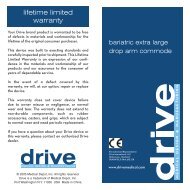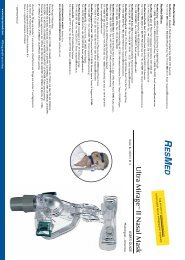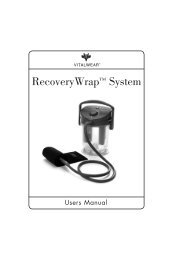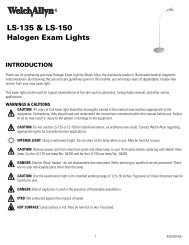AED 10 User Manual - Welch Allyn
AED 10 User Manual - Welch Allyn
AED 10 User Manual - Welch Allyn
Create successful ePaper yourself
Turn your PDF publications into a flip-book with our unique Google optimized e-Paper software.
82 Specifications <strong>Welch</strong> <strong>Allyn</strong> <strong>AED</strong> <strong>10</strong> Automated External DefibrillatorSummary of studies of waveform safety and effectivenessIntroductionStudy 1ObjectiveMethodsOver 30 years ago, Medical Research Laboratories (MRL) patented a unique monophasictruncated exponential waveform, which utilized a low peak current, impedancecompensated defibrillation waveform. The MRL monophasic waveform was developed asan alternative to the monophasic damped sine (MDS) waveform (often referred to as theEdmark waveform) defibrillator, which was associated with higher peak currents and didnot actively compensate for varying patient impedances. In fact, the MRL monophasicwaveform defibrillator delivers less than half of the peak current of an MDS waveformdefibrillator at equal delivered energies. A new defibrillator (the <strong>Welch</strong> <strong>Allyn</strong> <strong>AED</strong> <strong>10</strong>) hasbeen introduced, which offers a biphasic truncated exponential waveform thatincorporates MRL's original low peak current, impedance compensation design. The MRLOrbital biphasic truncated exponential waveform has been extensively tested in multiplescientific safety and effectiveness studies. Over 524 fibrillation/defibrillation shockepisodes have been conducted using the MRL Orbital Biphasic waveform comparing it toMDS, MTS and another commercially available 2kV biphasic (360 J capable) defibrillators.Results of three of the scientific safety and effectiveness studies are summarized below.To evaluate the MRL Orbital Biphasic waveform defibrillator against a monophasicdamped sinusoidal waveform defibrillator.A canine model (n=5, 71±7 lbs) was used in a study that was approved by the InstitutionalAnimal Care and Use Committee. The animals were anesthetized with 20 mpk sodiumpentothal i.v., and maintained as required through an intravenous catheter in the foreleg.The external jugular vein was cannulated and a bipolar pacing catheter was introducedunder fluoroscopic control and advanced into the right ventricle. The femoral artery wascannulated and an intra-arterial line was placed for continuous measurement of arterialblood pressure. The chest was shaved and defibrillating patch electrodes (R2 part number3200-1715) were placed on the left and right chest walls.Fibrillation was induced by delivering 60 Hz current to the right ventricular electrode. Theenergy required to defibrillate was determined by a protocol that has been used in severalother biphasic comparison studies. An initial shock strength of 50 to 70 joules was used. Ifsuccessful, VF is reinduced after a 4-minute rest period, and the shock strength isreduced by approximately 20% for the next defibrillation attempt. If the initial shock fails, arescue shock is delivered, and after a rest period, VF is again induced. The energy is nowincreased about 20% for the next defibrillation attempt. This procedure was continueduntil at least 3 reversals in result were observed with each waveform. Two ED50estimation procedures were run in parallel, with the device being used alternated on eachshock. In practice, actual clinical units were used, so the energy steps were limited tothose selectable on the devices tested.


